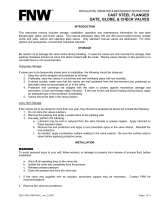Page is loading ...

INSTALLATION
MANUAL
for KLINGER® gaskets

INSTALLATION TIPS
FOR KLINGER® GASKETS
SUITABILITY
Check on chemical resistance
STORAGE
Check on storage conditions
PT-DIAGRAMS
Review the pt-Diagrams

INSTALLATION INSTRUCTIONS
FOR KLINGER® GASKETS
1.1 CORRECT SIZE
✓The gasket has to have the correct size.
1.2 BOLT HOLES
✓Cut the bolt holes just a bit larger than the bolts
to simplify the centralization of the gasket.
1.3 INNER DIAMETER
✓The inner diameter of the gasket should not be
smaller than the inner diameter of the flange.
3.1 PROTECT THE GASKET
✓All types of gaskets (metallic gaskets, PTFE
gaskets, fibre reinforced gaskets etc.) should
be handled with the same care and attention.
✓Avoid carrying small gaskets in a pocket to
protect the gasket from damage.
✓Carry ready cutted gaskets carefully, ideally in
some form of protective cover.
GASKET
DIMENSIONS
1. STORAGE2. HANDLING3.
2.1 IDEAL STORAGE CONDITIONS
✓The gasket should be stored horizontal to
avoid tensions and permanent warpage.
✓Ideal storage conditions are:
»temperature < 25°C
»air humidity 50 - 60%
»darkened storage room
»Store the gasket in a clean condition
(ideally in a plastic bag).
3.2 PROTECT THE SURFACE
✗Do not bend the gasket and do not damage
the surface.
CUT THE BOLT HOLES
LARGER THAN THE BOLTS
3.3 TAKE CARE
✓Metal reinforced gaskets could cause injuries.

4.1 BOLT PROPERTIES
✓Pay attention that all bolts which are designed
for the flange are installed.
✓Check if the used bolts are suitable for the
given operating temperatures.
✓Tighten the bolts crosswise with the correct
torque (calculation with KLINGER®expert).
✓Ensure that there is no corrosion on the bolts
because this can effect the function of the bolt.
✗Never re-use bolts.
4.2 NUT PROPERTIES
✓Use a nut which has a specified proof load
20% higher than the ultimate strength of the
fastener.
✓Use standard threads, rather than fine.
✓Use the correct lubricant.
4.3 WASHERS
✓Use the same material for the washers and
the nuts.
✓Use washers to:
»bridge slotted or oversized holes
»even interface forces between joint compo-
nents
»reduce problems of fatigue by spreading the
load placed by the fastener on the joint.
5.1 THE TOOLS
✓At first make sure that the following tools are
available and in good condition:
»the correct gasket chosen for the specific
application
»a calibrated torque wrench
»a wire brush
»lubricants for the bolts
5.2 CLEANING OF ALL FLANGE
SURFACES
✓Make sure that the flange surfaces are clean.
✓Check the bolts and the flange surface if they
are technically ok and free from any serious
defects.
✓Always brush in the direction of the grooves.
✓To avoid damage on the flange surface please
use a brass drift.
5.3 FLANGE CONDITIONS
✓Make sure that the flanges are parallel and
report all irregularities.
5.4 IMPORTANT FOR THE GASKET
✓Insert the gasket carefully between the flanges.
✓The gasket has to be centralized in the flange.
✓Ensure that the gasket is installed in a dry
state.
✓It is important that the gasket is not pinched or
otherwise damaged when bringing the flanges
together.
5.5 LUBRICATION OF BOLTS
✓Apply lubricant to the bolt and
the nut threads as well as to
the face of the nut to reduce
friction when tightening.
✓Pay attention that the
lubricant does not cont-
aminate the gasket or the
flange surfaces.
✓The recommended service temperature of the
lubricant has to be within the process service
temperature limits.
GASKET
INSTALLATION
5.BOLTS / NUTS /
WASHERS
4.
MAKE SURE THE GASKET IS UNDAMAGED
WHEN BRINGING THE FLANGES TOGETHER

30%
60%
100%
5.6 BOLT TIGHTENING
✓The required torque value can be calculated
with KLINGER®expert.
✓The following 5 steps are necessary to achieve
an even torque:
»finger tighten bolts (cross pattern)
»use 30% of the required torque (cross pattern)
»use 60% of the required torque (cross pattern)
»use 100% of the required torque
(cross pattern)
»Close the torquing with two final passes in a
clockwise sequence.
5.7 RE-TIGHTENING
✓If retightening is considered necessary, this
should only be done at ambient temperatures
before or during the first start-up.
✗Never retighten compressed fibre gaskets
at higher operating temperatures and longer
operating times.
5.8 RE-USE OF GASKETS
✗For safety reasons never re-use a gasket.
✓The cost of a gasket is minimal compared with
the costs which are related to a down time of
the plant.
THE GASKET HAS TO HAVE
THE CORRECT SIZE

KLINGER Danmark
Tel +45 43 64 66 11
info@klinger.dk
www.klinger.dk
/

